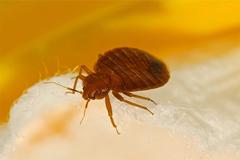Blog Post
Recent Posts
Bed Bug Treatment & Best Practices

The most effective insecticides are those used by trained and licensed professionals and may often require specialized equipment to apply.
Using bug bombs and sprays on mattresses and in bedrooms will increase your exposure to health risks of control and will spread bed bugs.
Never Use Dangerous DIY Methods
There are hundreds of ineffective and possibly dangerous DIY methods out there. Don’t put your family, home or business at risk!
- “Bug bombs” will only spread the infestation.
- Using standard space heaters to combat bed bugs is not a safe option as they are not manufactured to heat rooms to temperatures that would be lethal to bed bugs.
- Over the counter insecticides are ineffective and can cause health risks to your loved ones.
What are the signs of a bed bug infestation?
For most people, the first sign of a bed bug problem may be waking up with unidentified bites. Bed bug bites are usually similar to other insect bites.
- Fecal (Poop) stains: They often resemble minute ‘ink dots’, are often mistaken for mold and can be found just about anywhere.
- Cast skins: This is when the bed bug grows out of its skin and leaves the old one behind. Finding traces of this may be an indication of a bed bug infestation.
- Blood stains: These spots may look like rusty spots on bedclothes, sheets, furniture and surrounding walls and are another pointer that your house may be inhabited by bed bugs.
- Live Bed Bugs: Look for live bed bugs in any stage of development although you may not always find.
Where do bed bugs hide?
Bed bugs are often times associated with areas where we sleep or rest but can easily spread and be found in adjacent rooms. However, they are commonly found in the following places:
- Seams and creases of mattresses and box springs
- Headboards and bed frames
- Carpet edges, base boards, molding, cracks and crevices behind and around bed.
- Switch plates and electrical outlets, loose wall paper and picture frames.
- Upholstered chairs and nightstands.
- Piled up clothing or any cluttered areas.
Bed Bug Prevention Tips
- Check for signs of bed bugs regularly
- Carefully inspect all clothing and baggage when you return from traveling. Place clothing and belongings in sealed plastic bags until they can be run in a hot dryer [loosely packed] set on the highest temperature for at least 35- 45 minutes.
- Avoid acquiring used furniture and mattresses from secondhand stores – they may be infested.
- Remove clutter from the home, especially the bedrooms where bed bugs can find new places to hide.
- Use solid, light-colored sheets to make early detection of bed bugs easier.
- Mattress encasements are also good measures of preventing infestation as they help keep bed bugs from entering your mattresses.
- Do not move infested items from one room to another as bed bugs may fall off during the process.
- Be careful not to transfer bed bugs to your car.
Bed Bugs are known to be one of the most difficult pests to eliminate. It is important to find them in the earliest stages for efficient elimination.
